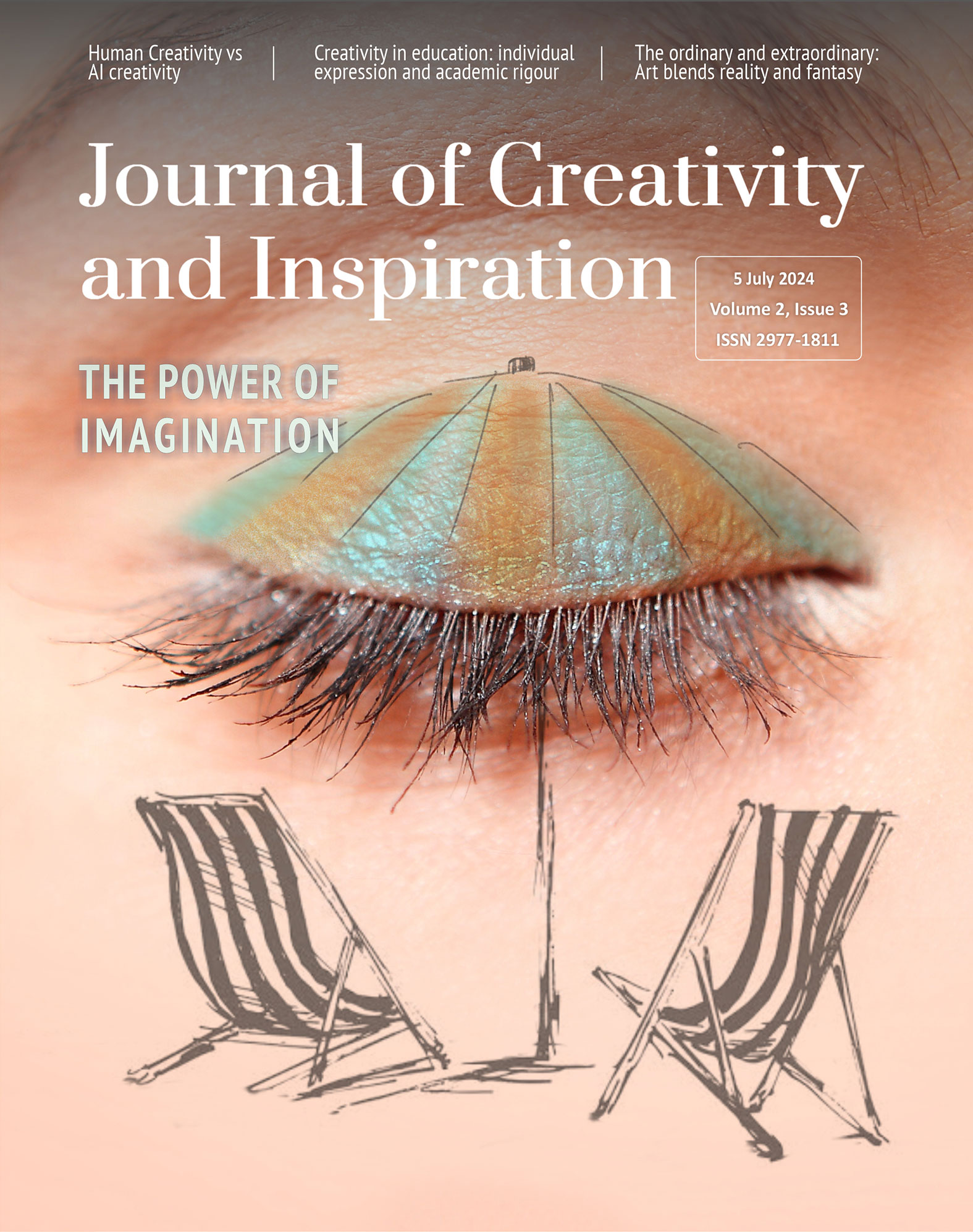Where time is irrelevant: Emma Louise Harris interviewed by Gil Dekel
5 July 2024 – Vol 2, Issue 3.
Gil: We can see free-flowing lines in your art, but also very measured geometric shapes. There are organic shapes and geometric shapes.
Emma: Generally, I’m not really thinking about that. I just start painting without any preconceived idea of what it’s going to look like. Sometimes I might think about colour, ‘I’m going to use blue to start with’ but I don’t necessarily think, ‘Right, I’m going to do a spiral’ or ‘I’m going to do straight lines’. I simply start painting and see what happens. People find that quite surprising, but that’s how I do it. On the other hand, the compositions in some of my arts do look very measured, and the shapes don’t look random – they look intentional.
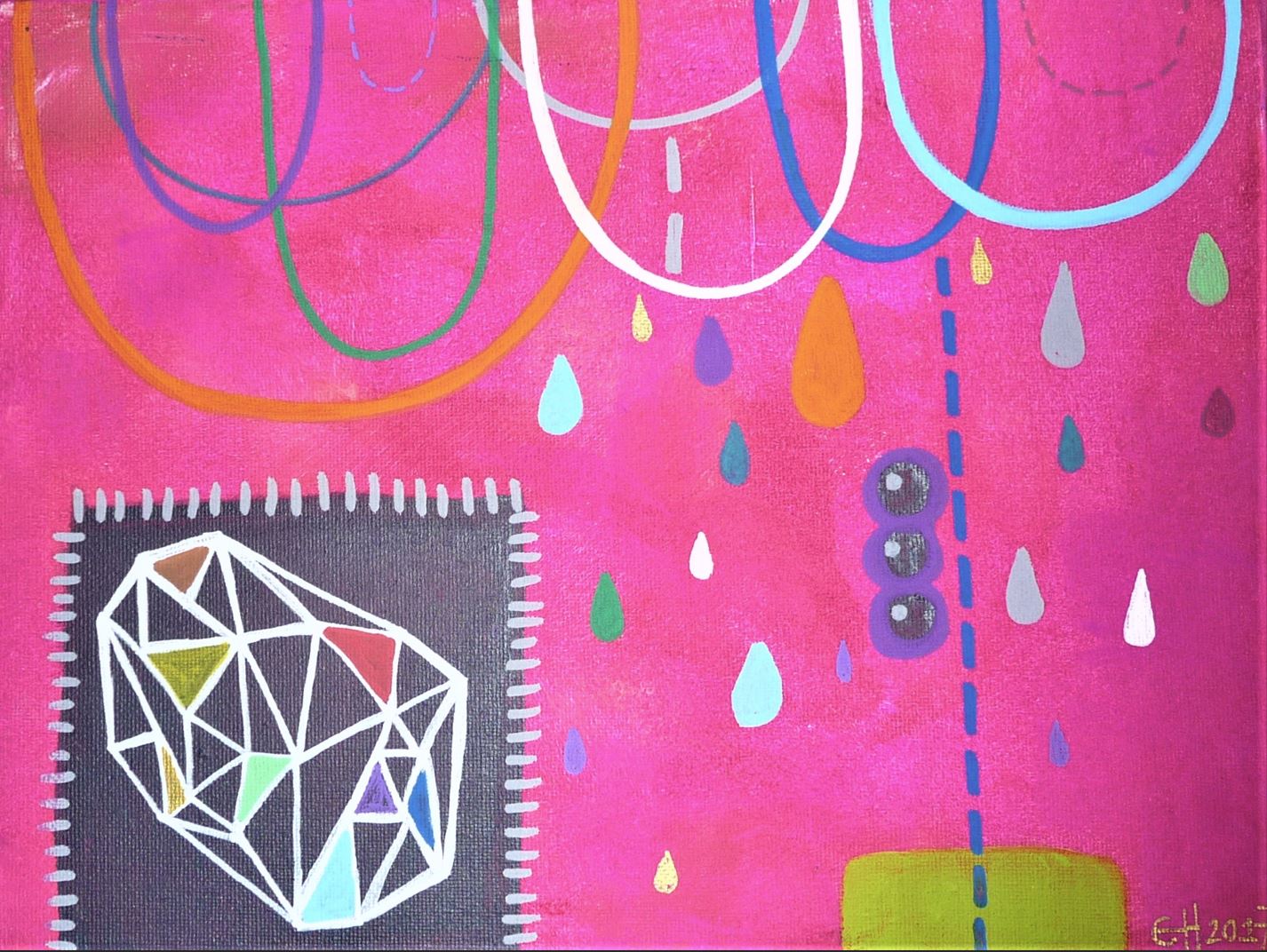
‘Boxy Lady’, acrylic on canvas, 20cm x 30cm. 2017.
Gil: How do you work with colours?
Emma: I really enjoy colours. It’s mostly about the colours, choosing them and seeing how they pop against each other. Normally, I have several paintings on the go at any one time. It’s rare that I’m just doing one. I’ve got maybe four or five canvases, and I’ll use some colour on one, leave it to dry, start another one, do some colour on that, and just build up the layers.
I might turn the canvasses upside down, look at things from different angles to decide the composition. I keep using layers and layers until I’m happy. If there’s a bit I don’t like, I paint over it and focus on the parts I do like. I use Posca pens for all the lines and details when the canvas is dry enough. I start doodling and filling in different bits. The feeling is that I’m channelling something. I don’t mean channelling a God, but there’s a part of me that knows what’s happening, and I just let it manifest itself.
I don’t think it’s a conscious thought. It’s subconscious, with a lot emotions and feelings. It’s almost like meditation, very intuitive; my rational brain isn’t much a part of it. It’s just a flow when you reach the point where time is irrelevant, and you’re so immersed in it.

‘Verdure’, acrylic on canvas, 60cm x 60cm. 2019.
Gil: When you go into that creative zone, what happens there?
Emma: I can be painting for six hours and forget to drink or eat because I’m so in the zone. That’s when I enjoy it the most – when I forget everything else, the outside world, and I’m just fully focused on what I’m doing. I’ve been painting like this for about twelve years.
Music is a big part of it. I always listen to music when I’m painting. I feel like I need that kind of stimulation or inspiration. I can’t paint in silence. I remember once my phone died, so I couldn’t listen to any music, and I just had to stop. I didn’t want to carry on because I was not in the creative space anymore. I have that atmosphere which is almost like a ritual. If something goes wrong, it just stops the flow of what I’m doing.
Gil: And you have found that this flow works well with abstract art?
Emma: Yes. I went on an art retreat in 2012, in Somerset. I attended a workshop by an abstract artist, and that’s when it clicked that this was what I wanted to do. Some people do intricate art, like embroidery, or watercolours of landscapes. That doesn’t really appeal to me. I like being messy, slapping the paint on, letting it drip, and getting my hands dirty.
Gil: Which artists inspire your work?
Emma: I’ve always liked Rothko. His use of colour is beautiful and makes you feel a certain way. The Rothko room in Tate Modern, with its deep burgundy walls, is quite contemplative. My favourite artist growing up was Van Gogh. His use of colour is probably the most inspiring to me. The way he uses yellow and blue together makes me happy. I also like Georgia O’Keeffe – her use of colour and botanical themes.
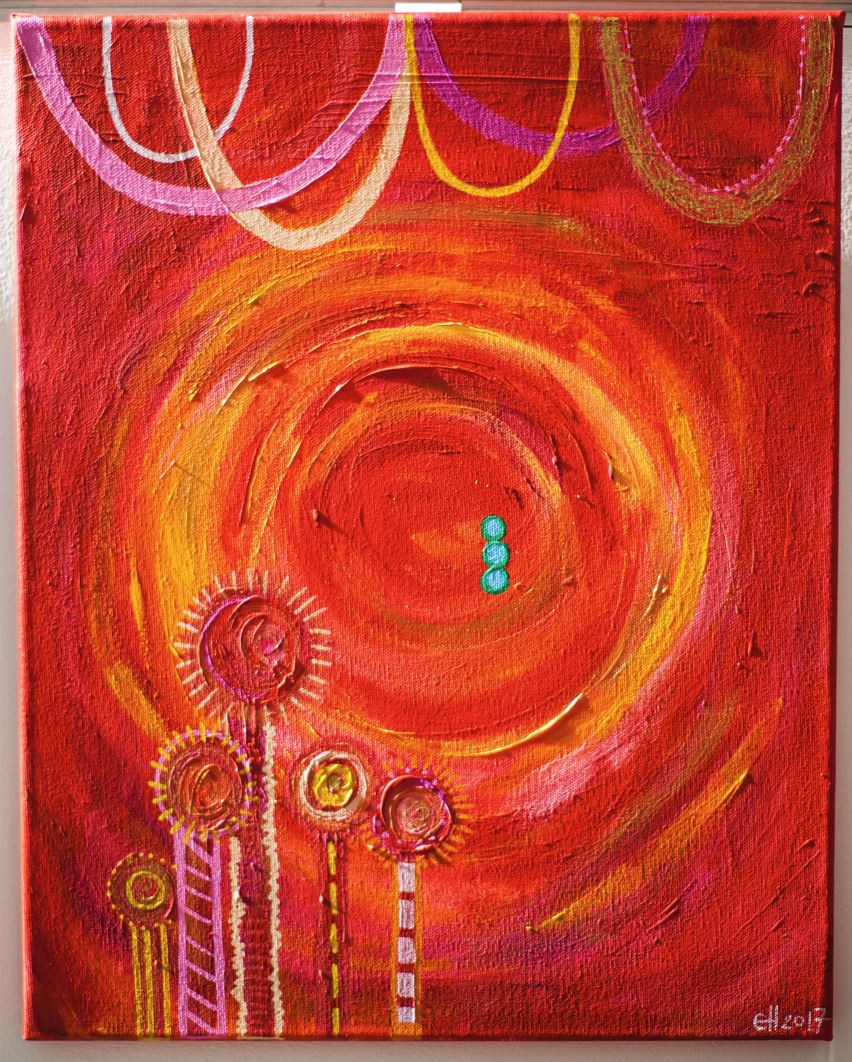
‘Hot’, acrylic on canvas, 50cmx40cm. 2017.
Gil: Do you consider the effect of hot versus cold colours?
Emma: Yes, they pop against each other. I have a painting called ‘Hot’ with hot colours and three green cold dots, and a painting called ‘Cold’ with cold colours and a couple of red hot dots. They bring out the best in each other.
Gil: How do you know when a piece is complete, and how do you choose the title?
Emma: It’s hard with abstract art because you could keep going forever. I usually think I might be done, put it aside, and come back to it later to see if anything needs tweaking.
As for titles, that’s difficult… I like to name them; I don’t like to leave them unnamed. I don’t want to repeat names, so I have to keep thinking of new words. It’s about how the piece makes me feel. The following work is called ‘Euphoria’ because it makes me so happy looking at it, with all its vivid colours.
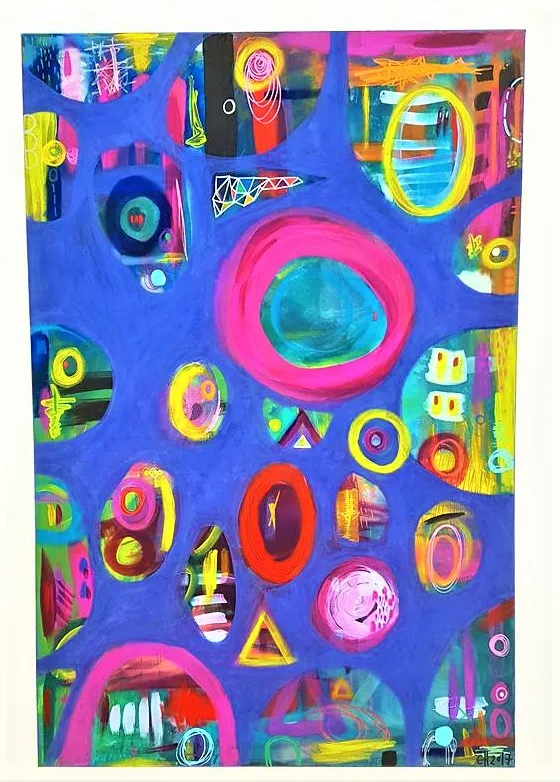
‘Euphoria’, acrylic on canvas, 80cm x 120cm. 2017.
Gil: Does your personal experience and background influence your work?
Emma: My family is very creative. My dad is a musician, my brother is a musician, and my mum is a quilter. Our house was always filled with quilts and musical instruments. We had lots of art on the walls and visited art galleries and museums with my parents when we were kids. It was probably unavoidable that I would be creative. When I was a kid, all my aspirations were creative – maybe a florist, a graphic designer, or an interior designer. I always wanted to do something creative. I enjoyed art at school a lot. I didn’t know I wanted to be a painter then, but it was kind of meant to be.
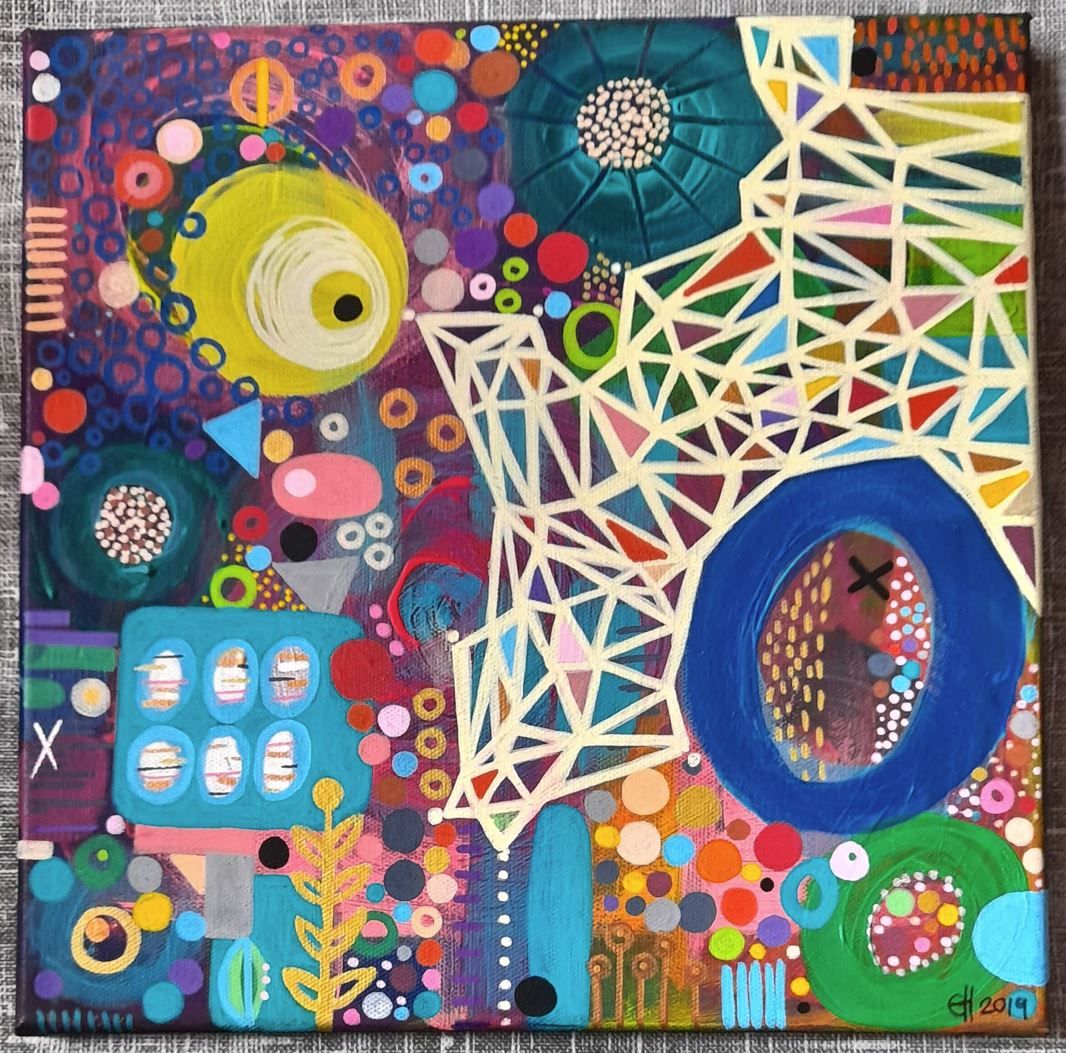
‘Cosmos’, acrylic on canvas, 28cm x 28cm. 2019.
Gil: You use acrylics in your works.
Emma: Yes. I prefer acrylics because they’re versatile and dry quickly, which suits my layering technique. They allow me to build up textures and details without waiting too long. Acrylics are also great for achieving vibrant colours, which is crucial for my work. The quick drying time helps me maintain the flow of my process, moving from one layer to the next without too much downtime.
Gil: What about texture and depth?
Emma: My work is two-dimensional – painting on a canvas – but an important element is the layers. I create in layers. I build up the layers with colour and detail, creating an illusion of depth. It’s about making the artwork look rich and full, even within the confines of a flat surface. There’s depth and texture, even if it’s not physically sticking out.
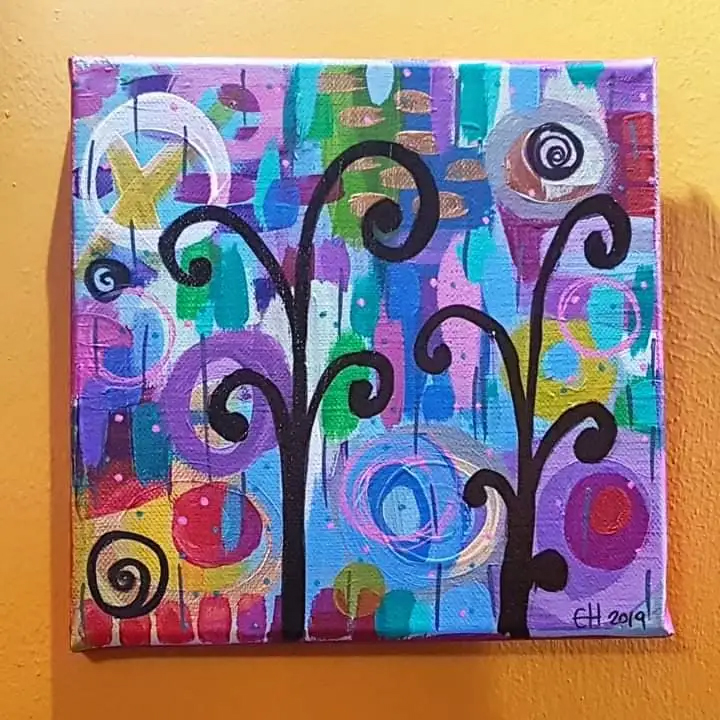
‘Vivid’, acrylic on canvas, 21cm x 21cm. 2019.
Gil: Do you think about the viewer’s experience when you are creating?
Emma: Not while I’m painting. I’m more focused on the process. It’s only when I’m nearing completion that I might think about how others will perceive it. But during the actual creation, I’m too immersed in the process. It’s about the joy of painting and the emotional release it provides.
Even if I never sold anything again, I’d still create art because I love it. My art journals, which I’ve been keeping since 2008, are just for me. There’s no commercial element to them. It’s just passion. Art is my passion.
Gil: Do you think your work is alive?…
Emma: That’s a good question. Yes, I think it is. It’s so vibrant, isn’t it? I never thought of it like that, but yes, I’d say it’s alive. There’s a vividness and liveliness in the expression, and people say they resonate with that.
At a glance:
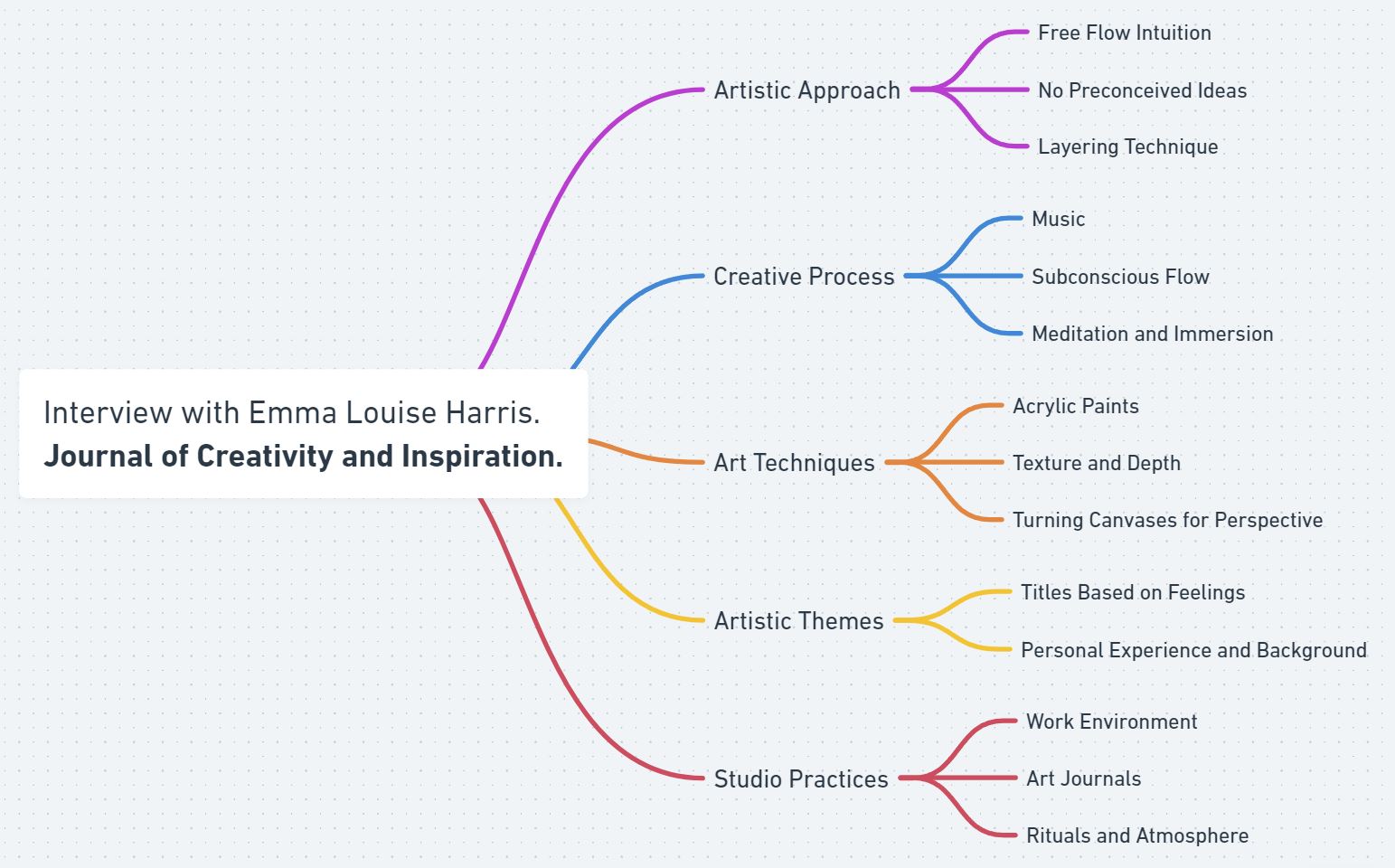
© Journal of Creativity and Inspiration.
Images/art © the artists.
Emma Louise Harris is an artist based in Southampton and has a studio space at The Arches since 2019. She paints abstracts and keeps art journals, which are like visual diaries. She studied textiles and has been painting in her current style since 2012.
Gil Dekel is a doctor in Art, Design and Media, specializing in processes of creativity and inspiration. He is a lecturer, visionary artist, Reiki Master/Teacher, and co-author of the ‘Energy Book’. He was awarded the Queen Elizabeth II Platinum Jubilee Coin, in recognition of his dedication and commitment to pastoral work at Hampshire Constabulary.
